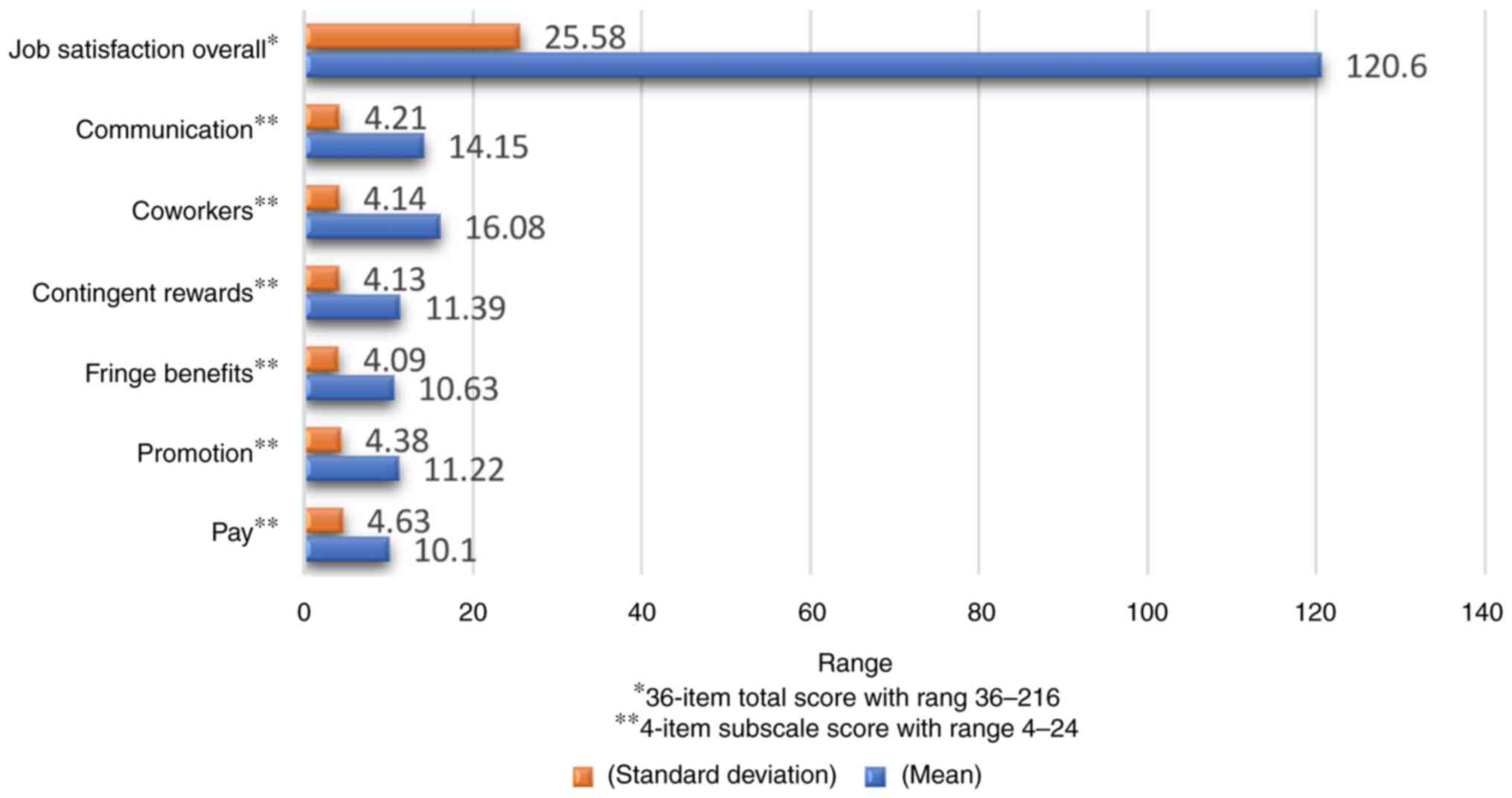|
1
|
World Health Organization (WHO): Pulse
survey on continuity of essential health services during the
COVID-19 pandemic: Interim Report. WHO, Geneva, 2020.
|
|
2
|
Locke EA: The nature and causes of job
satisfaction. In: Handbook of industrial and organizational
psychology. Dunnette MD (ed). Rand McNally, Chicago, IL,
pp1297-1349, 1976.
|
|
3
|
Scheepers RA, Boerebach BC, Arah OA,
Heineman MJ and Lombarts KM: A systematic review of the impact of
physicians' occupational well-being on the quality of patient care.
Int J Behav Med. 22:683–698. 2015.PubMed/NCBI View Article : Google Scholar
|
|
4
|
Williams ES and Skinner AC: Outcomes of
physician job satisfaction: A narrative review, implications, and
directions for future research. Health Care Manage Rev. 28:119–139.
2003.PubMed/NCBI View Article : Google Scholar
|
|
5
|
Koontalay A, Suksatan W, Prabsangob K and
Sadang JM: Helathcare workers' burdens during Covid-19 pandemic. A
qualitative systematic review. J Multdiscip Healthc. 14:3015–3025.
2021.PubMed/NCBI View Article : Google Scholar
|
|
6
|
Chigwedere OC, Sadath A, Kabir Z and
Arensman E: The impact of epidemics and pandemics on the mental
health of healthcare workers: A systematic review. Int J Environ
Res Public Health. 18(6695)2021.PubMed/NCBI View Article : Google Scholar
|
|
7
|
Pappa S, Ntella V, Giannakas T,
Giannakoulis VG, Papoutsi E and Katsaounou P: Prevalence of
depression, anxiety and insomnia, among healthcare workers during
the COVID-19 pandemic: A systematic review and meta-analysis. Brain
Behav Immun. 88:901–907. 2020.PubMed/NCBI View Article : Google Scholar
|
|
8
|
Tsounis A and Sarafis P: Validity and
reliability of the Greek translation of the job satisfaction survey
(JSS). BMC Psychol. 6(27)2018.PubMed/NCBI View Article : Google Scholar
|
|
9
|
Spector PE: Measurement of human service
staff satisfaction: Development of the Job Satisfaction Survey. Am
J Community Psychol. 13:693–713. 1985.PubMed/NCBI View Article : Google Scholar
|
|
10
|
Thai TT, Le TAT, Truong LTT, Le NH, Huynh
QNH, Nguyen TV and Tran HGN: Care for the Carers: An evaluation of
job satisfaction of community healthcare workers in charge of
infectious disease prevention and control in Vietnam. Risk Manag
Healthc Policy. 14:2831–2839. 2021.PubMed/NCBI View Article : Google Scholar
|
|
11
|
Yu X, Zhao Y, Li Y, Hu C, Xu H, Zhao X and
Huang J: Factors associated with job satisfaction of frontline
medical staff fighting against COVID-19: A cross-sectional study in
China. Front Public Health. 8(426)2020.PubMed/NCBI View Article : Google Scholar
|
|
12
|
Dinić M, Šantrić Milićević M,
Mandić-Rajčević S and Tripković K: Health workforce management in
the context of the COVID-19 pandemic: A survey of physicians in
Serbia. Int J Health Plann Manage. 36:92–111. 2021.PubMed/NCBI View
Article : Google Scholar
|
|
13
|
Said RM and El-Shafei DA: Occupational
stress, job satisfaction, and intent to leave: Nurses working on
front lines during COVID-19 pandemic in Zagazig City, Egypt.
Environ Sci Pollut Res Int. 28:8791–8801. 2021.PubMed/NCBI View Article : Google Scholar
|
|
14
|
Adams JG and Walls RM: Supporting the
health care workforce during the COVID-19 global epidemic. JAMA.
323(1439)2020.PubMed/NCBI View Article : Google Scholar
|
|
15
|
Blake H, Yildirim M, Wood B, Knowles S,
Mancini H, Coyne E and Cooper J: COVID-well: evaluation of the
implementation of supported wellbeing centres for hospital
employees during the COVID-19 pandemic. Int J Environ Res Public
Health. 17(9401)2020.PubMed/NCBI View Article : Google Scholar
|
|
16
|
Blake H, Zhou D and Batt ME: Five-year
workplace wellness intervention in the NHS. Perspect. Public
Health. 133:262–271. 2013.PubMed/NCBI View Article : Google Scholar
|
|
17
|
Cordoza M, Ulrich RS, Manulik BJ, Gardiner
SK, Fitzpatrick PS, Hazen TM, Mirka A and Perkins RS: Impact of
nurses taking daily work breaks in a hospital garden on burnout. Am
J Crit Care. 27:508–512. 2018.PubMed/NCBI View Article : Google Scholar
|
|
18
|
Nejati A, Rodiek S and Shepley M: The
implications of high-quality staff break areas for nurses' health,
performance, job satisfaction and retention. J Nurs Manag.
24:512–523. 2016.PubMed/NCBI View Article : Google Scholar
|
|
19
|
Papoutsi E, Giannakoulis VG, Ntella V,
Pappa S and Katsaounou P: Global burden of COVID-19 pandemic on
healthcare workers. ERJ Open Res. 6:00195–2020. 2020.PubMed/NCBI View Article : Google Scholar
|
|
20
|
Sinsky CA, Willard-Grace R, Schutzbank AM,
Sinsky TA, Margolius D and Bodenheimer T: In search of joy in
practice: A report of 23 high-functioning primary care practices.
Ann Fam Med. 11:272–278. 2013.PubMed/NCBI View
Article : Google Scholar
|
|
21
|
World Health Organization: Global strategy
on human resources for health: Workforce 2030, 2016.
|
|
22
|
Dunn PM, Arnetz BB, Christensen JF and
Homer L: Meeting the imperative to improve physician well-being:
Assessment of an innovative program. J Gen Intern Med.
22:1544–1552. 2007.PubMed/NCBI View Article : Google Scholar
|















